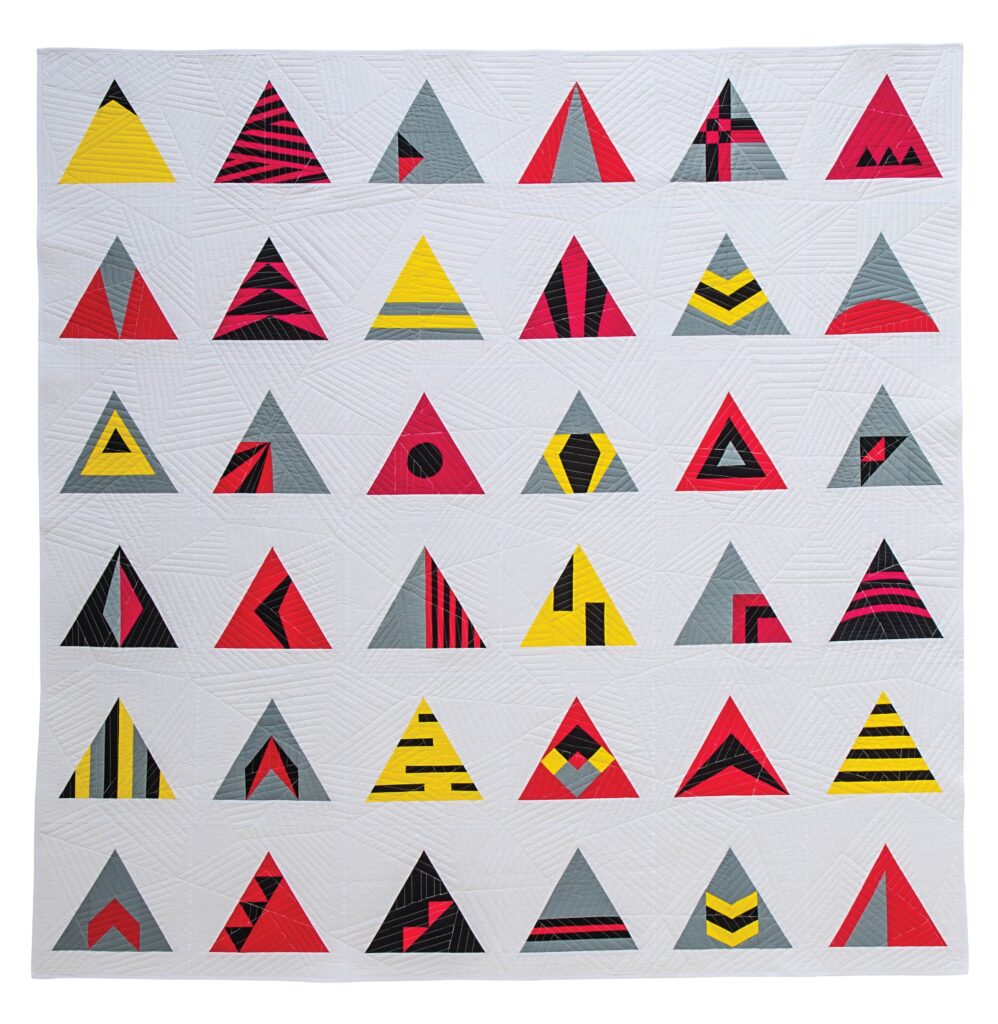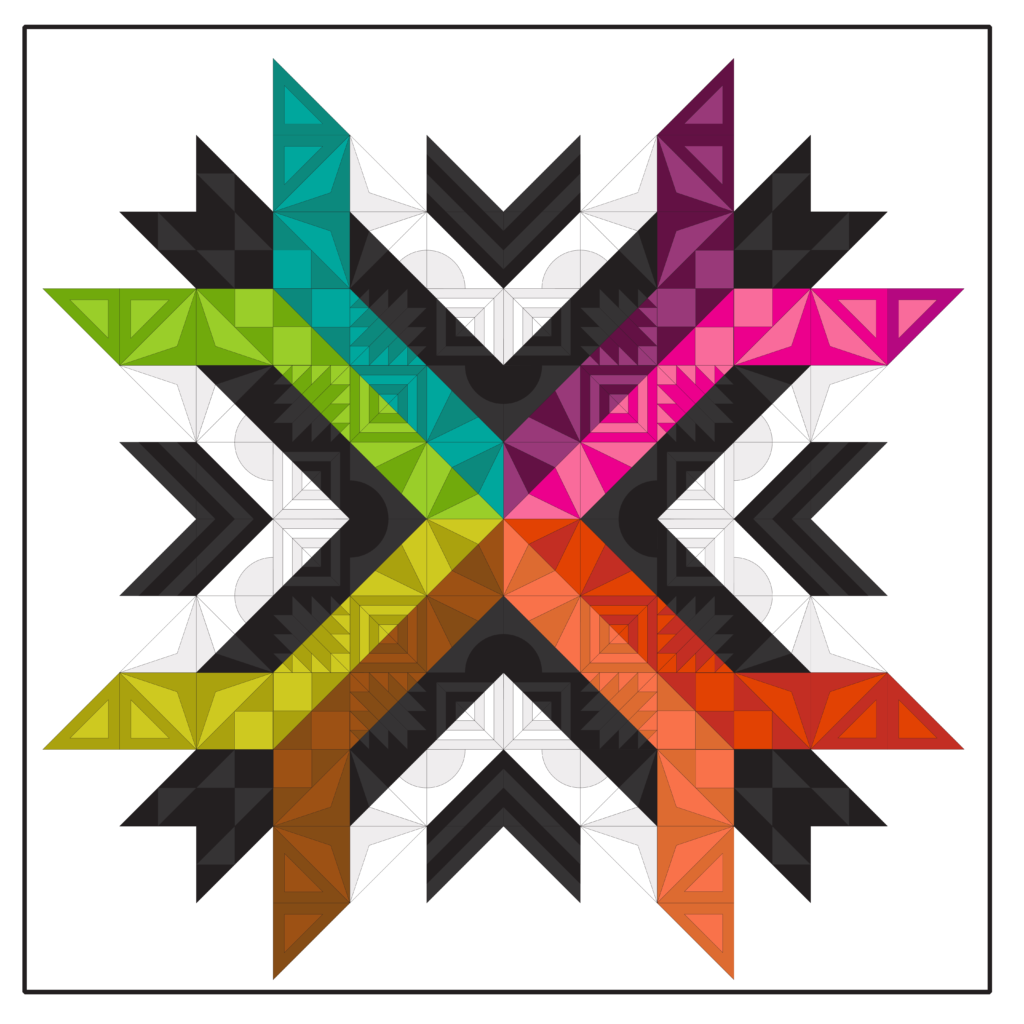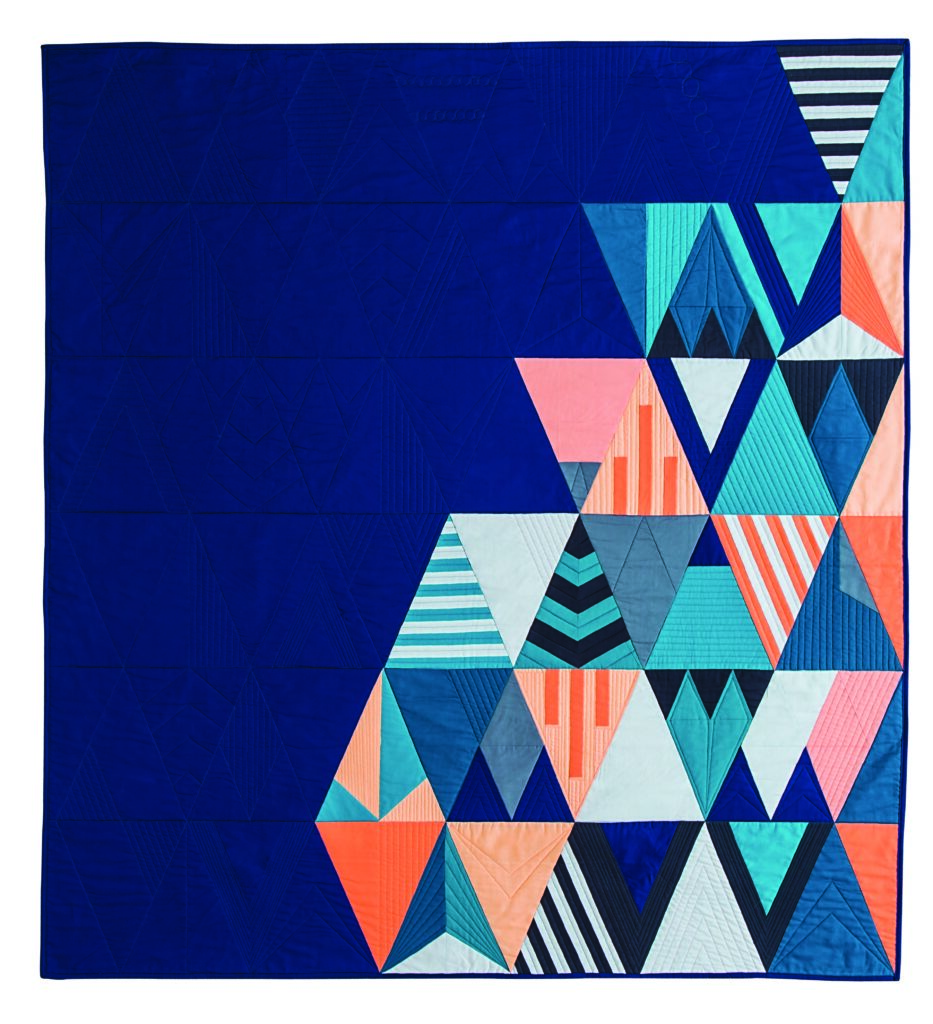Designing quilt patterns with modern triangles is a fun way to play with composition and principles of design. Compose your own modern triangle designs using my five mini example tutorials. You only need a few supplies to discover techniques that just plain work!

Key Takeaways
- Start your design process with a playful mindset.
- Create designs with a classic twist using modern triangle blocks.
- Play with symmetry to generate layouts.
- Alter layouts by subtracting parts of blocks or removing them to create negative space.
- Use the rule of thirds to balance a composition and add focal points.
Designing Quilt Patterns the Playful Way
Ditch stitching with me for a no-sew, no seam allowance day. I’m sharing examples of my quilts and how I designed each quilt. Learn how I did it and give it a try. Oh, and no math.
I start with leftover modern triangles and block ideas from my sketchbook. My design wall is great for trying out ideas. You can use a table or the floor – just move those pieces around! At that point, I don’t know where it’s going. A quilt designer spends a lot of time on unknown outcomes.
Prepping your triangles
If you need triangles to play with, take a few minutes to make some with fabric or paper.
Instructions: Gather up leftover triangles, cut out new ones or make a quick batch with paper – you only need a handful. Use favorite scrapbook page paper and mix and match fabric scraps from your stash. Make it pretty – leave the ugly stuff for another day! Next, cut out 2-inch squares and then cut them in half diagonally to quickly make a bunch.

HOW TO USE THIS TUTORIAL
As you read through the examples below, try out each design technique with your triangles.
Drawing block designs on graph paper is another way to generate ideas with the techniques. Quilters graph paper is great tool for doodling ideas. It’s available as downloads – check online for isometric graph paper for equilateral triangles and hexagons. You’ll find many options for quilters graph paper like this one here.
When you design something you like, make copies and cut them apart. You’ll get more triangles to play with.
Having said that, I prefer moving actual triangles around for layout. This is where the magic happens.
Tips for saving your work
- Make notes about what you like about each arrangement on a scrap of paper and snap a photo of them together. Your arrangements are temporary – no sewing today – so keep a visual record. You’ll be glad you did.
- Record your progress as you rearrange triangles – make short videos for each technique or fill journal pages with your layouts.

When I create a layout I like, I test my blocks in fabric. Big fan of test blocks. A good test block is always a good sign. My modern triangles also have a lot going on in the inside.
Often a quilt pattern designer heads straight to the computer with an idea. That’s all good. I’m better with a playful, hands on approach at the beginning stage. Simple is nice for a change!
When I’m ready to move forward with a design, I make freezer paper piecing foundations for my modern triangles using Adobe Illustrator. Everything is finalized in Illustrator – quilt blocks, layouts and foundations – in a digital format.
Quilt Design with Triangle Blocks
Writing a book about modern triangle quilts put me knee-deep in all manner of triangles: Isosceles, right, and equilateral. We really got to know each other. One triangle can send me in countless directions, including layouts and new blocks.
The book had to end eventually said my editor. 70 different triangle blocks and 11 quilts later. The experience schooled me in composition and design. So schooled.
When I learned more about how to design, my quilts worked better and I understood why they worked or didn’t work. No more guessing.

Next up, techniques that could become your techniques.
Classic with a Twist
Modern traditionalism is a quilting genre that riffs on classic quilt blocks. The quilt designer transforms the design by changing up the scale (larger or smaller), emphasizing secondary designs, negative space and changing the grid. These a just a few ways.
My 8-point star block Bright features mixed pieced triangles in a traditional design. See how I popped in modern triangles to refresh traditional star quilt blocks?
The finished blocks reflect classic roots and modernism at the same time. Classic with a twist.

Designing quilt patterns: Build a Shape
Choose a shape to fill in with modern triangles – such as a diamond, star, wild geese or heart. You might discover 3-D effects in your design. Oooooooo!

The Art of Arrangement
Delve into creatively arranging your triangles with a boost from symmetry. When I design a quilt, symmetry is always considered. Through strategic placement, your triangle quilt blocks elevate a loose collection of ideas into a dynamic quilt design.
Play with Symmetry on a Grid
Symmetry plays an important role in design – it makes automatic eye-pleasers.
Quilters, we like symmetry, yes? Symmetry is balanced and appealing – THINGS ARE IN THEIR PLACES!
For this technique, choose a grid – HST, equilateral or Isosceles. You can use square graph paper if that’s all you have – the lines are just guardrails! Fill in your grid using one type of symmetry defined below.
Mirror symmetry: When the design is folded in half, each half acts like a mirror to the other. The Right Triangle Sampler quilt mirrors the pattern and triangle shapes horizontally, but not the designs inside the triangles. Keepin’ it interesting.

Equilateral Sampler creates mirror symmetry in the quilt’s vertical halves. Designing quilt patterns with symmetry works well for beginner quilters and triangles.

Translational symmetry: Think about it like a footprint, where the pattern moves along the grid in a given distance in a given direction. Each section is identical.

Radial or rotational symmetry: Each section of the quilt repeats around a center point. Radial symmetry appeals to me because there is balance and constant movement at the same time.

There are more types of symmetry to explore that I haven’t used yet.
Tradition and Subtraction

Tradition and subtraction is a spinoff of your symmetrical grid designs. By moving a block or two, asymmetry is often created. Asymmetrical layouts add a modern flair to any modern quilt.
I used a traditional flying geese block, then subtracted blocks. I also removed colors in some triangles, making them part of the background or negative space.
Upstart is a modern triangle quilt with blocks subtracted (photo below) and “added” back in with the quilted triangles. Like many modern quilts, I used several methods in this quilt: scale with differently sized triangles, negative space, repetition,
Balancing the positive and negative blocks is like whack-a-mole. Move one triangle block and they all look off-balance. Just keep going until it’s Goldilocks right.

Flame quilt was designed on a diamond grid with Isosceles triangles. I subtracted color to create asymmetry.

To achieve a well-balanced asymmetrical quilt layout, try these techniques:
- Create visual lines (seen and unseen) using the block edges throughout the entire quilt top.
- Use quilting on the surface to repeat a shape in negative space, like a watermark. There, but not there.
- Extending lines from all the blocks throughout the entire quilt surface.
- Breaking up large sections of negative space into manageable parts.
Rule of Thirds
The rule of thirds is like a tic-tac-toe board with 9 sections. Using the principle of thirds, a fundamental principle designers use, just plain works.
It works like this: Make a grid divided into nine sections based on thirds. Place focal point elements at the intersections and about one-third away from any edge or border. Emphasize the focal points with color or quilting.
For example, Tribute, a star-shaped quilt pattern, used only 36 blocks placed in the lower right third of the quilt top.

Stardust is another examples of the rule of thirds. This design principle is also known as nearly asymmetrical. It’s not exactly half and not quite one-third, two-thirds. It’s teetering on the edge!

Hello, Modern triangle Quilt Pattern
What do you think about your layouts?
Will you design a quilt with modern triangles? Maybe stitch a few together. Snap a pic and call it done – you had fun. I know, a quilt top is a big commitment (call it a project instead?) And yes, you can design a quilt with confidence using these techniques.
When I design a quilt with a modern feel, these techniques do not disappoint. Especially when I run into a glitch with fabrics, ideas that don’t work in real life, or a block that doesn’t fit (darn you, seam allowance). I back it up to the composition stage and play again.
A note about fabric requirements – just something to consider. Designing quilt patterns with solid fabric colors is easier because I can always order more Kona solids. I often change things up – color, blocks, layouts – and I make mistakes. Plus, I like to use solid fabrics for a modern feel.
Need more quilting tips? Finish a modern quilt top with straight line stitching. See tutorials on my blog post, including Finish a Quilt – Stitch Methods for Quilt Tops.
Summary
I hope you had fun and generated lots of ideas using design principles and no-sewing techniques with modern triangles for quilted projects. Now design a quilt – you’ve got this!
Frequently Asked Questions Designing quilt Patterns
What is the best program for designing quilt Patterns?
For those who enjoy designing in software, Electric Quilt is a popular. It offers a wide range of layout, block and color possibilities, without cutting a single piece of fabric.
If you are a quilter who wants to design your own quilts, this program helps you make endless designs. Audition layouts, color schemes and blocks with a few taps on your computer.
How do you design a quilt layout?
Determine the scale and size of the blocks and what type of grid you will use. Next, you will create a plan before cutting all pieces for the entire quilt. Last, check your fabric requirements – have all the fabric you need for the layout size.
What makes a good quilt design?
A good quilt design is all about symmetry, lines, scale, color, values and movement.
How do you usually make a triangle quilt?
Use a popular method using half square triangles, also known as HSTs. To begin, place two same sized square pieces of fabric with the right sides facing each other. Make a diagonal line from an upper corner to a lower corner. Sew two quarter inch seam allowances on each side of the line. Cut along the center line to create two HSTs. Unfold to form squares and press the seams.
Give it a try! This technique is a colorful way to use triangles that become squares in a grid. Sewing squares into rows is the easiest piecing.
How can triangles add to modern quilts?
Triangle blocks are made with two or three diagonal lines which create movement and interesting patterns. By combining different modern triangle designs, exciting patterns emerge. Triangle blocks are easy to use in symmetrical and asymmetrical quilt layouts. Try quilting triangles on the quilt top adds another dimension.
BY THE WAY, THERE’S STILL TIME TO JOIN AURORA BOM!

Introducing the Aurora Block of the Month, an all NEW design for 2024! Colors and shpes create beautiful symmetry in this modern triangle quilt design.
Click here to learn more about Aurora Block of the Month.

Thanks Rebecca for all your wonderful work, support, and always ready to teach us something special and exciting.
You are just wonderful. You too have a wonderful weekend.
Thanks so much DeAnn!
I’m trying to love triangles and grow in creativity, your blog and links are so helpful! Thanks!
Woo hoo! I’m so glad!